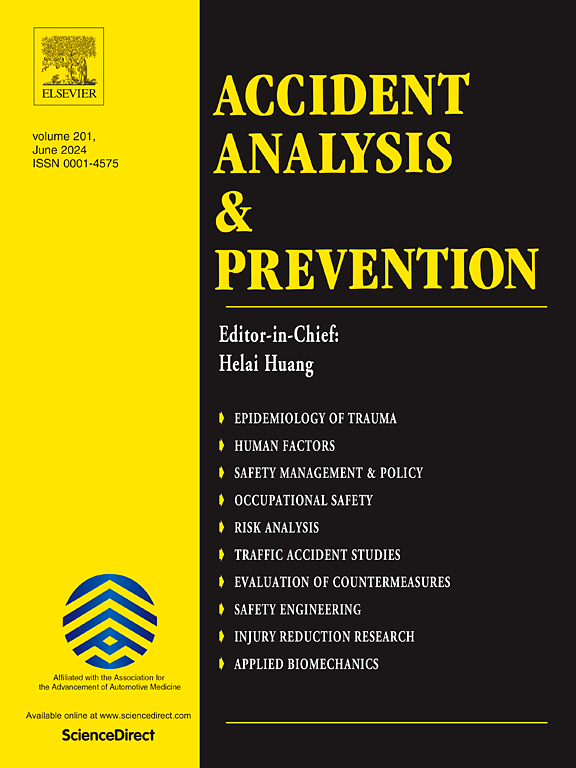A reliability analysis method based on cross-entropy importance sampling for lateral safety assessment of misaligned autonomous truck platoons under crosswinds
IF 5.7
1区 工程技术
Q1 ERGONOMICS
引用次数: 0
Abstract
Autonomous truck platooning offers a range of advantages in freight transportation, including energy efficiency and operational effectiveness, and has garnered increasing attention. But traditional truck platoons, typically aligned in a straight line, can cause channelized damage to road surfaces due to the concentrated load over short durations. To enhance pavement sustainability, the concept of misaligned truck platoons has been explored, wherein trucks within the platoon intentionally drift laterally by varying amounts. Nevertheless, the misalignment introduces concerns regarding the lateral safety performance of the trucks. To investigate the lateral safety of misaligned autonomous truck platoons under crosswinds, this paper introduces an innovative and efficient approach. Using a three-truck platoon as an example, Cross-Entropy Importance Sampling (CE-IS) is utilized to estimate the lateral risk probability of misaligned truck platoons with a randomized distribution across multiple indicators, and the results are compared with those obtained using the Monte Carlo Simulation (MCS). The results indicate that CE-IS significantly reduces computation time while maintaining high accuracy. This computational efficiency makes CE-IS particularly suitable for intelligent freight systems, where rapid and reliable risk assessment is critical for dynamic platoon coordination, real-time safety management, and optimization under uncertain conditions. Under a consistent in-lane lateral distribution control mode, misaligned truck platoons are more prone than aligned platoons to encroaching into adjacent lanes, thereby increasing the risk of accidents. However, reorganizing the middle truck in a misaligned platoon to establish a misalignment distance away from the lane marking can reduce the lateral risk probability, though it remains slightly higher than that of aligned platoons. This study contributes to the efficient and accurate quantification of lateral risk in vehicle platoon systems. Additionally, it provides valuable insights into enhancing the lateral safety of coordinated truck platoons and mitigating their impact on road surfaces. And this method combining CE-IS proposed in this study can efficiently quantify and calculate the lateral risk of vehicle platoons in intelligent freight systems, providing suggestions for real-time operational strategies.
基于交叉熵重要抽样的侧风条件下自动排车横向安全可靠性分析方法
自动驾驶卡车车队在货运方面具有一系列优势,包括能源效率和运营效率,并受到越来越多的关注。但传统的卡车排通常排成一条直线,由于短时间内的集中负荷,可能会对路面造成渠化破坏。为了提高路面的可持续性,人们探索了不对齐卡车排的概念,其中排内的卡车故意以不同的数量横向漂移。然而,这种不对准引起了人们对卡车横向安全性能的担忧。为了研究侧风作用下不对齐自动驾驶卡车队列的横向安全性,本文提出了一种创新而有效的方法。以某三辆卡车排为例,利用交叉熵重要性抽样(CE-IS)方法对随机分布的多指标卡车排的横向风险概率进行了估计,并与蒙特卡罗模拟(MCS)方法进行了比较。结果表明,CE-IS在保持较高精度的同时显著减少了计算时间。这种计算效率使得CE-IS特别适用于智能货运系统,在智能货运系统中,快速可靠的风险评估对于动态排协调、实时安全管理和不确定条件下的优化至关重要。在一致车道内横向分布控制模式下,不对齐的卡车排比对齐的卡车排更容易侵占相邻车道,从而增加事故风险。然而,重新组织排中的中间卡车以建立偏离车道标线的距离可以降低横向风险概率,尽管它仍然略高于排对齐。该研究有助于有效准确地量化车辆排系统中的横向风险。此外,它还为提高协调卡车排的横向安全性和减轻其对路面的影响提供了有价值的见解。该方法与CE-IS相结合,可以有效地量化和计算智能货运系统中车辆排的横向风险,为实时运营策略提供建议。
本文章由计算机程序翻译,如有差异,请以英文原文为准。
求助全文
约1分钟内获得全文
求助全文
来源期刊

Accident; analysis and prevention
Multiple-
CiteScore
11.90
自引率
16.90%
发文量
264
审稿时长
48 days
期刊介绍:
Accident Analysis & Prevention provides wide coverage of the general areas relating to accidental injury and damage, including the pre-injury and immediate post-injury phases. Published papers deal with medical, legal, economic, educational, behavioral, theoretical or empirical aspects of transportation accidents, as well as with accidents at other sites. Selected topics within the scope of the Journal may include: studies of human, environmental and vehicular factors influencing the occurrence, type and severity of accidents and injury; the design, implementation and evaluation of countermeasures; biomechanics of impact and human tolerance limits to injury; modelling and statistical analysis of accident data; policy, planning and decision-making in safety.
 求助内容:
求助内容: 应助结果提醒方式:
应助结果提醒方式:


